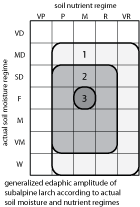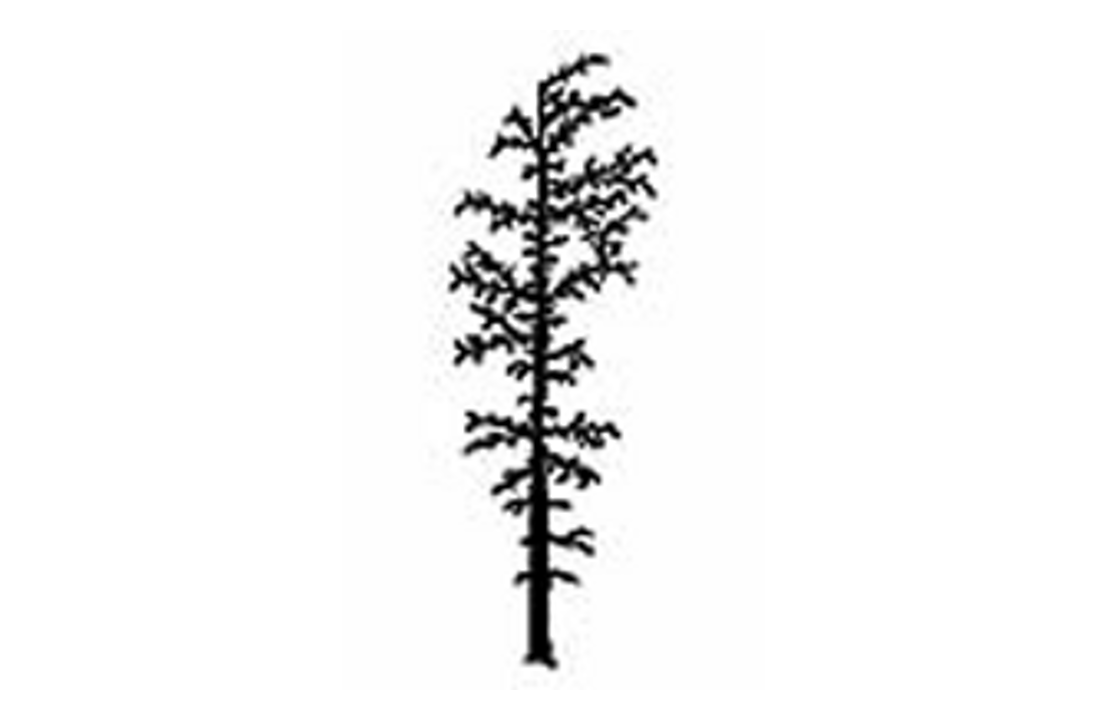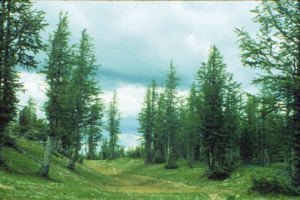Subalpine larch
Subalpine larch (La) - Larix lyallii
Subalpine larch, also called alpine larch, is a small- to medium-sized (rarely >30m tall), deciduous conifer, with a short, sturdy, and tapering stem; ragged, broad irregular crown; and yellowish-gray bark, with irregularly shaped, scaly plates.
Subalpine larch is an ecologically interesting and aesthetically attractive species but its wood has little commercial value.
On this page
- Geographic range and ecological amplitudes
- Tolerances and damaging agents
- Silvical characteristics
- Genetics and notes
Geographic range and ecological amplitudes
Geographic range
Geographic element
Distribution in Western North America:central in the Cordilleran region
Ecological amplitudes
Climatic amplitude:
(alpine tundra) - subalpine boreal
Orographic amplitude:
subalpine - (alpine)
Occurrence in biogeoclimatic zones:
(lower AT), upper - (lower) southern ESSF
Subalpine larch is well adapted to a continental subalpine boreal climate. It grows in the transition between the upper southern portion of the ESSF zone and the adjacent AT zone between 1800m and 2300m. It forms a timberline there together with subalpine fir, (Engelmann spruce), and whitebark pine. It tolerates very severe winters (the absolute minimum of -56 degrees C has been recorded). Occasional chinook winds of very dry air during the winter rarely affect subalpine larch to a lethal degree because of its deciduous habit, while evergreen conifers may be severely affected because moisture lost rapidly from foliage cannot be replaced.
Edaphic amplitude

Range of soil moisture regimes:
(moderately dry) - slightly dry - fresh - moist - very moist - (wet)
Range of soil nutrient regimes:
poor - medium - rich - (very rich); calciphytic
The nutrient amplitude of subalpine larch is not well known. Field studies indicate that it is absent on very poor sites and grows somewhat better on calcium-rich substrates, such those derived from calcareous quartzites, sandstones, or argillites. However, very rapidly drained limestones are less favorable substrates in drier climates than other sedimentary and igneous rocks.
Tolerances and damaging agents
Root system characteristics
Subalpine larch roots extend deep into fissures in skeletal or rocky substrates. Trees are very windfirm as they are well anchored by a large taproot and several large lateral roots. The crown and trunk of old trees may break off in storm winds but the trees themselves are seldom uprooted. Roots of subalpine larch are associated with both ecto- and endo-mycorrhizae.
| Tolerance to | Tolerance class | Comments |
|---|---|---|
| Low light | L | A very shade tolerant, exposure requiring species |
| Frost | H | .Low growing season temperatures are common in subalpine forests |
| Heat | L | |
| Water deficit | M | Droughts are uncommon in upper subalpine forests |
| Water surplus | H | Infrequent on waterlogged sites |
| Nutrient (mainly N) deficiency | M | Tolerates poorly strongly acidic soil |
| Damaging agent | Resistance class | Comments |
|---|---|---|
| Snow | H | Common in snowslide and avalanche areas |
| Wind | H | Common on exposed ridges. |
| Risk class | ||
|---|---|---|
| Fire | L | Not a major concern in upper ESSF forest |
| Insect | L | |
| Fungi | L | Not a serious concern in the upper ESSF forest (brown trunk rot, larch needle blight) |
Associated tree species and successional role
In British Columbia, subalpine larch grows more in pure stands of irregular size and scatter clumps rather than in mixed-species stands. It typically forms open, park-like groves, <0.02 ha in size, interspersed with opening of various sizes. Subalpine larch is a pioneer species (primary succession) on snowslides, collovium, and rock outcrops, and may be present as a minor component in the upper ESSF forest.
| Subalpine fir | L | upper southern ESSF |
| Engelman spruce | L | upper southern ESSF |
Genetics and notes
Genetics
Races, varieties, or subspecies of alpine larch are not known.
Notes
Considering the ecosystems in which it grows and its productivity, subalpine larch is not a timber crop species but a valuable timberline species for watershed protection, wildlife habitat and outdoor recreation.



